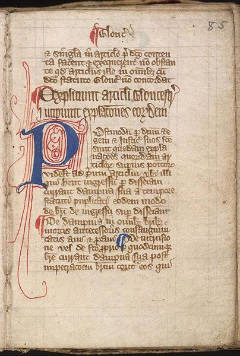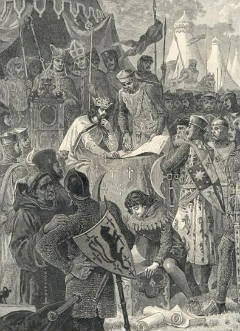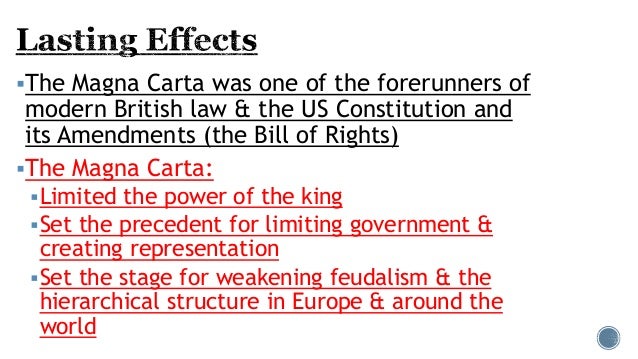The Magna Carta (wiki), the basis of the thesis that leaders are not above the law, the beginning of the path from absolute monarchy to the rule of law, and an important foundation of our Anglo-Saxon liberties, was signed on June 15, 1215.
The British Library has produced two illustrated videos on it, narrated by Monty Python's Terry Jones - see below. First, a couple of quotes:
Nullus ballivus ponat decetero aliquem ad legem simplici loquela sua, sine testibus fidelibus ad hoc inductis.~Magna Carta, clause 38
(In future, no official shall place a man on trial upon his own unsupported statement, without producing credible witnesses to the truth of it.)
Nullus liber homo capiatur, vel imprisonetur, aut dissaisiatur, aut utlagetur, aut exulietur, aut aliquo modo destruator, nec super eum ibimus, nec super eum mittermus, nisi per legale judicium parium suorem vel per legem terrae.
~Ibid., clause 39
(No free man shall be taken or imprisoned or dispossessed, or outlawed or exiled, or in any way destroyed, nor will we go upon him, nor will we send against him except by the lawful judgement of his peers or by the law of the land.)
Nulli vendemus, nulli negabimus aut differemus, rectum aut justitiam.~Ibid., clause 40
(To no man will we sell, deny, or delay right or justice.)
The Magna Carta (wiki) (the "Great Charter") was signed by England's King John at Runnymede, south of London. John, the youngest son of Henry II, reigned from 1199 to 1216 and aroused fierce opposition in both the nobility and the church for his high-handed authoritarianism.
The resulting bloodless rebellion ended when John - under compulsion - signed the Great Charter, drafted in Latin by the British clergy, that guaranteed both baronial and ecclesiastical rights and privileges and the customs of the towns.* Of course, as soon as the barons left London, John renounced the document and then appealed to Pope Innocent II, who technically still ruled England. The Pope declared the Magna Carta null and void. It was modified, re-issued and reaffirmed a handful of times until the final version of 1225**, and is now considered the most important document of English constitutional history. Four contemporaneous copies remain extant in England.***
A few clauses of the Magna Carta became part of the American government: Clause 39 (quoted above), or habeas corpus, provides that arrests and trials of citizens must have merit and is found in Article One of the U.S. Constitution. Clause 61, which called for a committee of barons to oversee the king's actions, inspired the "checks and balances" system.
"The underlying idea of the sovereignty of law, long existent in feudal custom, was raised by it into a doctrine for the national State. And when in subsequent ages, the State, swollen with its own authority, has attempted to ride roughshod over the rights and liberties of the subject, it is to this doctrine that appeal has again and again been made, and never, as yet, without success."
* N.B. To get a flavor of some of the other clauses, consider these:
1. The English Church shall be free, and shall have its rights undiminished, and its liberties unimpaired.
13. The City of London shall enjoy all its ancient liberties and free customs, both by land and by water. We also will and grant that all other cities, boroughs, towns, and ports shall enjoy all their liberties and free customs.
30. No sheriff, royal official, or other person shall take horses or carts for transport from any free man, without his consent.
.jpg) |
| The original - click here to embiggen |
54. No one shall be arrested or imprisoned upon the appeal of a woman for the death of anyone except her husband.
** Cato has an good synopsis of the revision process: Getting King John To Sign Magna Carta Was Only Half The Battle
*** Originally, a large number of copies were made for the barons and for distribution among the English counties. Of these "first editions," four survive. One is on display at the Houses of Parliament, one is in the British Library, and one is in a cathedral in Salisbury, England. The fourth copy is usually housed at Lincoln Cathedral in Lincolnshire, but is occasionally loaned out.
The British Library explanation of Magna Carta, narrated by Monty Python's Terry Jones:
Another in the same series:
Horrible Histories: find out how Magna Carta came to be in the Horrible Histories 800 years Song:
Neatorama has a reprint of a good article from Uncle Johns's Unsinkable Bathroom Reader on the history of Magna Carta.
Related, Mark Steyn's The Field Where Liberty Was Sown, on re-learning those lessons.
Parts of the text above are based on Ed's Quotation of the Day, only available via email - leave your email address in the comments if you'd like to be added to his list. Ed is the author of Hunters and Killers: Volume 1: Anti-Submarine Warfare from 1776 to 1943 and Hunters and Killers: Volume 2: Anti-Submarine Warfare from 1943.
Related, Mark Steyn's The Field Where Liberty Was Sown, on re-learning those lessons.
Parts of the text above are based on Ed's Quotation of the Day, only available via email - leave your email address in the comments if you'd like to be added to his list. Ed is the author of Hunters and Killers: Volume 1: Anti-Submarine Warfare from 1776 to 1943 and Hunters and Killers: Volume 2: Anti-Submarine Warfare from 1943.





http://www.magnacartadocumentary.com
ReplyDeleteCheers
The basis for Jefferson's explanation of the legal justification for Government in the Declaration of Independence.
ReplyDelete